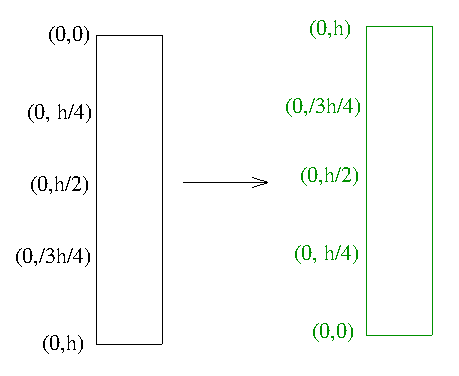- It always takes me at least twice to get things into the right location.
- Then I mess up the sign when moving things.
- We will fix this later.
- But for now, I will draw things in the "old" canvas coordinate system.
- We will be doing some linear algebra next.
- To make things work, we need to change a little about how we think about points.
- Not too much, but
- let's just represent a point in two space as [x,y,1].
- And no matter what, we want to keep that 1 there.
- We will delay the why for just a bit.
- If you want some real math theory, you can look into homogeneous coordinates.
- It would be really nice to have the origin at the bottom of the screen, not the top.
- We wouldn't have to "flip" the y coordinate all of the time.
- If you think about it, we really need to subtract the y value from the canvas height.
-

- For (0,0) we have h-0 = h.
- For (0,h) we have h-h = 0;
- For (0,h/4) we have h-h/4 = 3h/4
- (x,y) => [x,y,1]
- $a = \begin{bmatrix} x \\ y \\ 1 \end{bmatrix}$
- $T = \begin{bmatrix} a & b & c \\ d & e & f \\ g & h & i \end{bmatrix}$
- $ T \times a = \begin{bmatrix} a & b & c \\ d & e & f \\ g & h & i \end{bmatrix} \times \begin{bmatrix} x \\ y \\ 1 \end{bmatrix} = \begin{bmatrix} ax + by + c & dx + ey + f & gx + hy + i\end{bmatrix}$
- $ A \times B \ne B \times A$
- $ \begin{bmatrix} x'& y'& 1 \end{bmatrix} = \begin{bmatrix} 1 & 0 & 0 \\ 0 & -1 & h \\ 0 & 0 & 1 \end{bmatrix} \times \begin{bmatrix} x \\ y \\ 1 \end{bmatrix}$
- $x' = 1x + 0y + 01 = x$
- $y' = 0x + -1y + 1h = h-y $
- $ 1= 0x + 0y + 1*1 = 1$
- So $ \begin{bmatrix} x'& y'& 1 \end{bmatrix} = \begin{bmatrix} x& h-y & 1 \end{bmatrix} $
- Why do we want that 1 at the end of our coordinates?
- There is a transformation matrix
- Before a point is drawn, it is multiplied by the transformation matrix to move it to the "proper" location.
- So all points are "left alone".
- They do not give access to the full 2d Matrix.
- $T = \begin{bmatrix} a & c & e \\ b & d & f \\ 0 & 0 & 1 \end{bmatrix}$
-
ctx.setTransform(1, 0, 0, -1, 0, height);
- This will set a,b,c,d,e,f from above.
- Notice that once I do this, my scene is "flipped".
- That is nice.
- The context has the ability to save the current state.
-
ctx.save();
- And restore the previous value
-
ctx.restore();
- The context maintains a history of these matrices in the form of a stack.
- Save will push the current matrix on the top of the stack.
- Restore will pop the top of the stack and make that the current matrix.
- As we will see, this is a relative elegant solution.
- The reflection about the y axis as we discussed.
- A translation.
- This is the amount to move each point by.
- $T = \begin{bmatrix} 1 & 0 & tx \\ 0 & 1 & ty \\ 0 & 0 & 1 \end{bmatrix}$
- $ \begin{bmatrix} x'& y'& h' \end{bmatrix} = \begin{bmatrix} 1 & 0 & tx \\ 0 & 1 & ty \\ 0 & 0 & 1 \end{bmatrix} \times \begin{bmatrix} x \\ y \\ 1 \end{bmatrix}$
- $x' = 1x + 0y + 1tx = x + tx$
- $y' = 0x + 1y + 1ty = y + ty$
- $h' = 0x + 0y + 1*1 = 1 $
- Once again, note why we have the extra 1 in the coordinate system.
- This will be counter intuitive as the text is drawn "correct" for the default canvas.
- We will need to "flip" the text, but only the text.
- So before we draw the text we save the state.
- Flip the text
- Restore the state.
- $S = \begin{bmatrix} sx & 0 & 0 \\ 0 & sy & 0 \\ 0 & 0 & 1 \end{bmatrix}$
- $ \begin{bmatrix} x'& y'& h' \end{bmatrix} = \begin{bmatrix} sx & 0 & 0 \\ 0 & sy & 0 \\ 0 & 0 & 1 \end{bmatrix} \times \begin{bmatrix} x \\ y \\ 1 \end{bmatrix}$
- $x' = sx \times x $
- $y' = sy \times y $
ctx.scale(sx,sy);